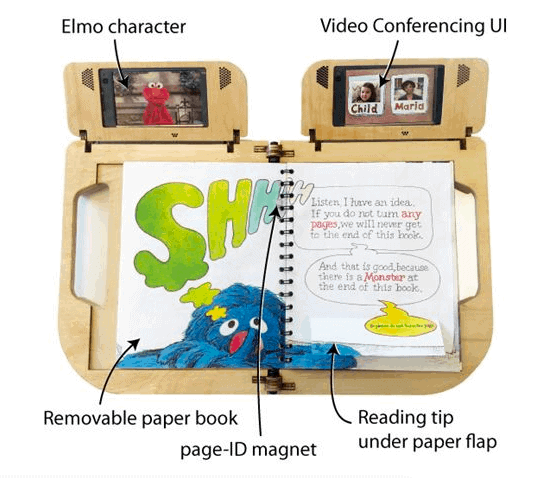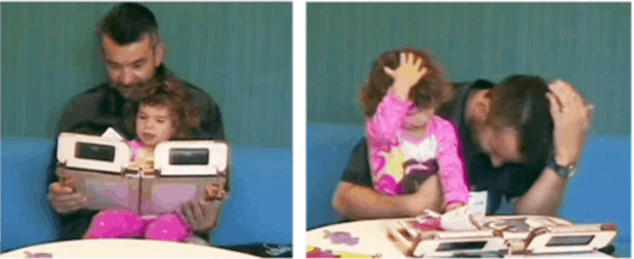Wizzle, a kazoo-like thingy
What is a Wizzle? They are kazoo-like trumpets with a giggly tube inside.
Blow in or out to make fun kazoo noises or shake it for a fun giggly
horn like sound. Loud, zany and fun!
What is a Wizzle? They are kazoo-like trumpets with a giggly tube inside.
Blow in or out to make fun kazoo noises or shake it for a fun giggly
horn like sound. Loud, zany and fun!
Hayes Raffle, Rafael “Tico” Ballagas, Glenda Revelle, et al., in Collaboration with Sesame Workshop

Family Story Play supports grandparents to read books together with their grandchildren over the Internet. Story Play improves communication across generations and over a distance, and to supports parents and grandparents in fostering the literacy development of young children.
The interface encourages active child participation in the book reading experience by combining a paper book, a sensor-enhanced frame, video conferencing technology, and video content of a Sesame Street Muppet (Elmo). These features improve child engagement in long-distance communication. Story Play also encourages dialogic reading styles that are linked with literacy development.
Family Story Play leverages a synergy between young children’s education—in this case, a rich shared reading experience—and communication with long-distance family. Our goal is to create new kinds of toys and tools that support creativity, learning, and family togetherness.

While at the MIT Media Lab Hayes invented Topobo, a construction toy with kinetic memory, the ability to record and playback physical motion. Since 2008 he has managed Topobo Co. as founder and principal.
With Topobo, you can snap together Passive (static) and Active (motorized) components to invent your own Topobo creature and animate it by pushing, pulling, and twisting its body. For example, you can make a dog and then teach it to dance and walk by twisting its body and legs. With the push of a button, the dog will dance and walk by itself. The same way children learn how buildings stand by stacking blocks, they can learn how animals walk by playing with Topobo.
Watch the Topobo video.
{website | videos | brochure | press | awards | papers | images}
Jabberstamp is the the first tool that allows children to synthesize their drawings and voices. To use Jabberstamp, children create drawings, collages or paintings on normal paper. They press a special rubber stamp onto the page to record sounds into their drawings. When children touch the marks of the stamp with a small trumpet, they can hear the sounds playback, retelling the stories they have created.
Children ages 4+ can use Jabberstamp to embed names, narratives, characters’ voices and environmental sound effects in their original drawings. Children’s compositions help them communicate their stories with peers and adults, and allow them to record and situate stories in personally meaningful contexts to share with others, before they have mastered writing.
Winner, Honorable Mention from I.D. Magazine Student Design Review.
{ website | brochure | video | papers | press }
Getup Blocks automatically rebuilds a block tower that a child has knocked over. My one-year-old daughter Paloma loves to knock towers over (towers made of blocks, sand, anything). Sometimes I can build thirty towers in a row and never lose her attention.
Getup Blocks examines whether Paloma remains interested in knocking over towers that are not built by a person. Was her activity about interacting with the material or the person – or both? Based on about two months of observation with an early prototype, I think the social interactions are more important for her, but the machine has meaning of its own.
In its first version, Getup Blocks rises and falls very slowly in an organic and unpredictable way. The slow falling seemed especially interesting for Paloma, and she would sometimes stand on the base and wrestle with the blocks for a long time. Eventually she won these wrestiling matches and the motor burned out. This version (pictured) is more robust using clutches and stronger materials. Also, the blocks getup very slowly, but always fall fast now.
This project emerged from an Interactive Toy Design Studio I taught at the MIT Media Lab.
I teach an Interactive Toy Design Studio to MIT grad and undergrad students.
Have a look at images of students’ work, at the course website.
This studio introduces students to fundamentals of interactive toy design and introduce basic design techniques and principles. Students build several toy prototypes in this class. We review related theory from the fields of design, fine art, education and cognitive science, and focus on fast ideation and implementation of ideas. Some readings related to design and learning are required, but the majority of the course is spent doing hands-on building. The course compresses a full semester into three weeks of intensive, daily design studios.
Topics Include
|
| |
| Product Redesign, Flash Magic Leapfrog wanted a friendlier, more functional design for their flash card decoder. | Asset Management Design and implementation of a visual database to manage and distribute thousands of graphic assets. |

ZOOB® is the first construction toy based on things that grow, from DNA to dinosaurs. Hayes worked with inventor Michael Grey to conceive and design the initial system. As employee #6 at Primordial, LLC, Hayes helped oversee all aspects of production design, including helping build and manage a design team to create product designs, packaging designs, and videos. The team won an ID Magazine award in the 45th Annual Design Review in Consumer Products and the toy has been popular for over twenty years.

